No seasoned turkey hunter will ever be found without a call or two… Or three. The sheer diversity and complexity involved in calling in these ornery birds has led to various calls and methods of using them. It isn’t as cut and dry as other game calls. Not only will you need to get the right call for the right situation, but you will need to make sure you are using it correctly.
This brief article cannot hope to be a guide to the use and technique of calling turkey. What it can do is help you decide which turkey calls are most effective in what instances. From there, there are tons of videos and articles from master callers that can get you working a call effectively.
Probably the best place to start is with some of the options out there and then go into the specifics.
- Read more: Best Time to Turkey Hunt
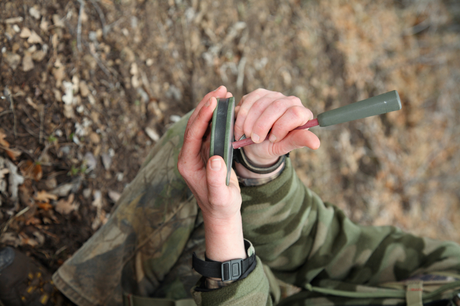
8 Best Turkey Calls 2019
1. Supreme Turkey Calls Strut Buster
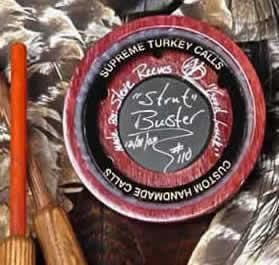
When you start looking into the best turkey calls, you will quickly find that most of them are custom made by master callers. That is the case with all of Supreme’s line of calls. They are made by one man, Steve Reeves, in his shop in Georgia. This does add a little to the price but the attention to detail and quality control are beyond any other brand on the market.
Though he offers three different varieties of calls, it is our thought that the Strut Buster is probably the most versatile call. With crystal and slate playing surfaces, this call has plenty of variety. Combine that with two different strikers and this little pot call can get a ton of unique sounds. Each one is tried and tested for perfect sound before it ships.
When you get a call from Supreme, it isn’t all about quality. Though that is the first concern, its always good to mix in a little natural beauty. We take pride in the things we own and the smooth carved Purplewood that makes up the body of this call is definitely prideworthy. Not only will it sound amazing but it has stunning good looks.
Pros
- Great Tone
- Superb Quality
- Very Attractive
Cons
- Expensive
- Harder to Use
2. Primos Tall Timber Gabriel

There are a lot of hunters who believe the box call is the king of calls and if that is the case, the king of box calls is the one made by Primos. If you are a hunter, you should recognize that name. They offer tons of great gear, most of which are top of the line. That is definitely the case with their turkey calls.
Much like a guitar or violin, the shape of the cavity in a box call dictates the sound. It’s probably best to think of a box call as an instrument, to begin with. The Tall Timber has dual thumb holes that can be manipulated and deep furls along the side for a sure grasp. If you want the best clucks and chirps, this is the call to get them.
The Sapele and Purpleheart wood give this a beautiful look and perfect tone. Every single Tall Timber is hand tuned just like a fine guitar. While these may qualify as mass-produced, they don’t have that mass produced feel. The material selection and craftsmanship are so spot on, it could be made custom.
Pros
- Amazing Sound
- Very Loud
- Beautifully Shaped and Crafted
Cons
- Can be tricky to learn
- Can be hard to find
3. Zink Night Owl
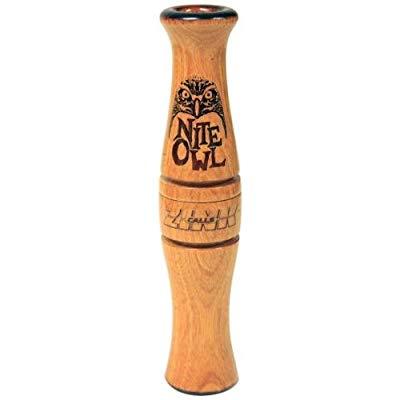
You gotta have a locator call and if you are going to get one, you might as well get the one the National Wild Turkey Federation uses. Zink calls are hand turned int the USA and worth their weight in gold for the avid turkey hunter. You simply won’t find a better call with a more uniform sound anywhere near this price. There may be some one-man custom shops that compete, but that is it.
If you are new to turkey hunting, it may seem strange to use a call that sounds like an owl but that is the way it’s done. And this Barred Owl call can be brutally effective at locating turkey. It has tons of volume and a tone that cuts through wind to reach out to where the big birds are hiding. Never go into the woods without one!
Made of striking Hedge Wood that has an immaculate finish for an amazing look. It isn’t all about the looks though, that same finish is what gives it the smooth, haunting owl call that is so natural, owls will often respond. If you hunt big property or are just starting your scout, you need this call!
Pros
- Very Effective Locator
- Easy to Use
- Loud
Cons
- Doesn’t Draw in Birds
- Not great in all situations
4. Hooks Custom Exterminator
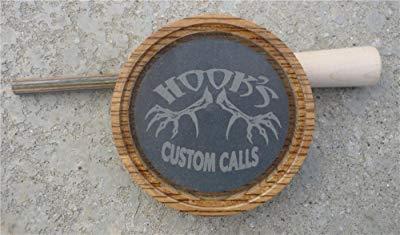
If you want a great pot call on a budget, you can count on Hooks Custom to get it. It could be argued that this is not exactly a custom call but when its designed by calling legend Steve Morgenstern, it’s probably best left alone. Custom or not, it still performs amazing and has that custom feel and sound.
The proprietary crystal-glass calling surface is among the best on the planet, requiring so little pressure to sound that it practically uses its self. The two-piece wood striker gets the perfect tone every time. While this is an amazingly easy call to use, don’t be lured into thinking it doesn’t take skill and practice. You will still need that.
Yelps on this pot call are loud and carry very well while cuts and cackles have that perfect warbling sound to them. This is simply one outstanding call and available on a tighter budget than a true custom call. If you only had one call in your box of tricks, it should probably be this one.
Pros
- Custom feel
- Affordable
- Best Possible Sound
Cons
- Takes Practice
- Tricky for New Callers
5. MAD Double Standard Box Call
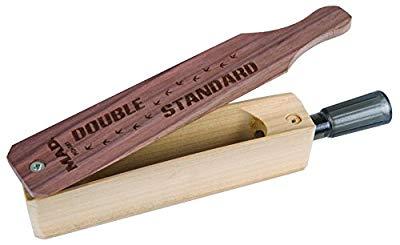
There is usually a problem when one product tries to do two jobs. While it isn’t perfect, MAD’s Double Standard has done a pretty good job at being two things at once. Not only is it a box call but with the included calling surface on the back and a striker built in to make it a pot call as well. This is easily among the most versatile calls on the market.
The box of this call is made of poplar and walnut and while these aren’t the most premium materials, they do look good and the sound is nearly spot on. It has a resin calling surface on the back and an all-wood striker. These are also not premium but seem to do the job quite well.
Honestly, as a box call, this is probably in the top 10% where sound and quality are concerned. It actually does an amazing job. The Pot Call setup is a little lackluster. It doesn’t have the volume of a traditional pot call though it does still produce decent effect. It could be described as a little too mellow for some but in close proximity, it works well.
Pros
- Amazingly Versatile
- Two Calls in One!
- Affordable
Cons
- Cheaper Materials
- Pot Call Not Great
- Not as Loud
6. Primos Hook Up Box Call
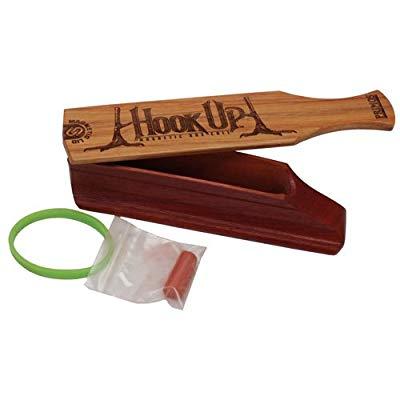
Another great call by Primos and if it falls short of being as good as their Tall Timber, it isn’t by much. Besides, it makes up for it by being much more forgiving and easier to use. This is actually quite an innovative concept that it will make you wonder why other calls don’t do the same thing. It can actually spoil you on box calls till you never want to use another.
It seems that sometimes the materials change for this call but it never seems to matter. It has a very consistent and loud tone that carries quite well. But what makes it innovating is the magnetic mounting that places it right on the side of your shotgun. This means you can operate the call and never have to put your gun aside. Just be careful if you fire with it still mounted.
The Hook Up also comes with the Primos trademarked Gobble Band which makes getting realistic gobbling sounds so much easier than with a normal box call. The tones may not be as spot on or easily controllable as with a higher-end box call but if you are just starting out, this is the perfect call to do it on.
Pros
- Very Affordable
- Innovative Design
- Very Realistic Sound
Cons
- Good calling can be tricky
7. Knight and Hale Smooth Operator

If you aren’t familiar, Knight and Hale are the famous producers of the calls used by the Bone Collector group. Not just this box call, but all of their calls. While most of those calls are actually quite good for the price, this one stands out as a shining star. As far as box calls on a budget go, this is probably the one to pick up.
The materials of this box are pretty no-nonsense, poplar is by no means a tough or durable wood. However, it does get really good harmonics and can perfectly mimic most clucks and cuts. This is made easier with the addition of thumb groves for precise control. The chamber produces loud sounds if not so refined as a high-end call.
Nothing in this should give you the impression that this call is not a good call. It is leaps and bounds above the cheap calls sold at most sporting goods and big box stores. It is a great call to learn on and one that is perfectly usable if not overly durable. You will want to upgrade eventually but if money is tight or just want to practice, this call will serve you well.
Pros
- Good Sound and Volume
- Affordable
Cons
- Cheaper Materials
- Can be tricky to get correct call
8. Quaker Boy Original Grand Old Master
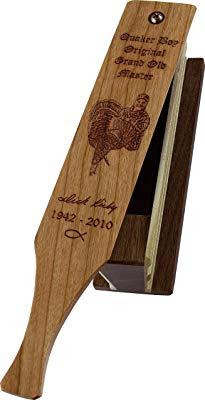
Named for legend Dick Kirby, the grand old master has likely called in more turkey in its tenure than all of the calls above combined. These are lovely, tonal calls that work very well and are a memoir to one of the greatest hunters and call makers of our generation. If you are a hunter, this is a solid call but if you collect calls this is a must-have.
For the price, this is simply a lovely call to look at with a cherry paddle and multi-wood base. Pretty isn’t all, the tone quality for the price is pretty good. If it’s off a little, that can probably be attributed to the wood laminates making up the base. It isn’t enough to drastically hurt the sound but enough for the discerning ear to move on.
The amazing thing is to get a call this good that is this attractive for such a budget price. It will definitely stand out of the crowd. Dick Kirby was a master caller and there is zero chance they would put his name on a call that didn’t work. You can get better calls if you want to invest but this call is always worth having.
Pros
- Very Beautiful
- Good Sound Quality
- Affordable
Cons
- Sound can be off
Types of Turkey Call
Types of turkey calls are broken down, by the way, the call functions as well as what the call does. In the calls below, most are by the actual mechanics of how the call works but one specifically, the Locator Call, is more on what the call does.

1. Box Call
This is the classic turkey call that has been around for eons, well at least since the late 1800s. They were likely invented before then but commercial production started sometime in that era. These function by drawing a wooden lid across a thin wooden box that serves as an echo chamber. This gives the call its volume and reverberation.
2. Push-Pull Call
A cousin to the box call, these slightly more modern versions use a box with a small dowel through it. Pulling and pushing the dowel gives a warbling sound reminiscent of a female turkey. These calls certainly have their dedicated following but are not as commonly used as some other types of calls. If you are a turkey hunter, they are well worth the moderate price if you want to give one a shot.
3. Pot Call
When they were building the dam for Kentucky Lake, they unearthed what is believed to be a very early version of the pot call. This was made by the pre-Columbian Native Americans and was dated at several thousand years old. These also went into mass production in the late 1800s. This is easily one of the most popular designs and it should be with such a long history. They work by scraping a small stick against a plate. The materials vary but can be wood, glass, aluminum, ceramic and many others.
4. Diaphragm Call
These are a modern invention though the theory is an old one used for many species of animals. A small ‘U’ shaped mouthpiece has a thin reed-like flap. When blown correctly, the slits in the flap will create a near perfect warble. These can be challenging to learn but for their modest price and effectiveness, they are well worth a shot.
5. Locator Call
No hunter worth his salt goes into the woods without a locator call. Many times, these mouth-blown calls don’t make a turkey sound at all. Owl sounds are quite common. The idea is that the sound produced through the call will elicit a response from any turkeys around. Since you can’t shoot ‘em if you can’t find ‘em, this is a good starting method.
6. Electronic Call
The new kid on the block is the electronic call. While electronic calls have been around for decades, they were often very large and heavy. Modern electronic calls are pocket-sized and have decent sound and volume. While these have yet to gain any real popularity in the very traditional sport of turkey hunting, they could prove effective. The main benefit is that they require almost no skill to use correctly.
Things to Consider Before Buying
While many of the calls above surely catch your fancy, before you buy you want to consider a few important points. Turkey are wary birds and it’s the aware hunter that gets them. Start that mentality when picking your equipment and you will stand a much better shot at success.
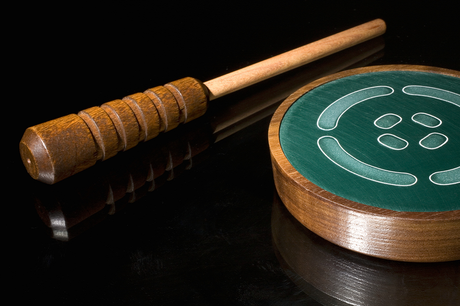
1. Learning Curve
Most turkey calls take some time to really learn to use and much more to master. When you pick your first call, go with one of the classics that are easier to get a good sound off of. Both the Box Call and Push-Pull Call are both good options. If you have some time to invest in learning, the Pot Call and Diaphragm call are both good options. If you don’t want to invest time in learning, get an Electronic Call and do your best.
2. Season
Different calls work better in different seasons. If you plan on hunting both seasons and only want one call, a Locator Call may be your best bet. For spring, calls that mimic female birds ready to mate are probably the best. For Fall, get a call that sounds like an older female, you are trying to get a flocking response.
3. Time of Day
Even the time of day can affect what calls are most effective. Calls that mimic birds wanting to mate are usually more effective in the morning. Locator calls can be more effective in the evening. If you only plan to hunt one time of day, pick a call best suited for that time. Most calls will have some effect at any time, it’s just a matter of which is most effective.
4. Get Local Help
If possible, find a local hunter and ask their opinion on call types. Most are willing to help but many have their own set in stone process. While their advice can be indispensable, take it with a grain of salt. You are better to get multiple opinions rather than sticking to a single source. Even this source.
There is a near mythology around turkey hunting, you have to get past that before you can find what works for you.
5. Try Various Calls
Turkey seasons are relatively short but the scouting for turkey is a year-round pursuit. Get several different calls and try them out as you scout. Learn what works, when it works, and get some valuable practice at the same time. Birds do move throughout the year and behavior is likely to change but this is the best method to get proficient while learning what works for you.
How to Turkey Call like a Pro
Conclusion
Calling turkey is nearly a sport on its own and has its own champions and masters. Many of the calls out there are designed and/or built by those people who have invested a lifetime in learning the turkey and how to hunt them. Just do yourself a favor and don’t get a cut-rate call. Most great calls are only marginally more expensive than a cheap, ineffective call. Buy it right the first time.
Once you have the right call, all that is left is learning how to use it. Consult every resource on the topic you can find and listen to some calls on Youtube or whatever other media source you can find. Knowing how it should sound is the best first step to learning how to make those sounds yourself.

